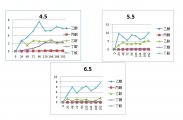降解木聚糖菌群生产生物丁醇的研究

降解木聚糖菌群生产生物丁醇的研究(任务书,开题报告,外文翻译,论文7500字)
摘要
化石能源是目前广泛使用的不可再生能源,使用该能源的过程中会产生对环境造成污染的气体。丁醇作为替代化石能源的新型能源极具发展前景。生产丁醇的方法分为化学法和生物法。近年来由于石油价格上涨,石油资源紧缺,发酵法制丁醇的价值得以显现。本文通过从秸秆堆放处的泥土取样筛菌取得可以以木质纤维素为原料发酵生产丁醇的混菌群。首先在不同的ph下培养菌群考察ph对菌群产丁醇的影响。得出结论:在ph为4.5时菌群具有较高的丁醇产物合成能力。然后在不同糖浓度下培养菌群考察糖浓度对产丁醇的影响,结果表明木聚糖浓度为60g/L时丁醇产量最高。最后考察铁离子与锌离子浓度对产量的影响并得出结论,Fe离子对这种混菌产丁醇有抑制作用,相反适当的锌离子则能够促进混菌将中间产物丁酸转化为丁醇,从而提高了生产丁醇的效率和生产强度。
关键词:梭菌发酵,pH,糖浓度,微量浓度
Abstract
Fossil energy is a widely used non renewable energy source. The process of using this energy will cause pollution to the environment. Butanol, as a new energy source to replace fossil energy,is a potential fuel with a bright future. The method of producing butanol is divided into chemical and biological methods. In recent years, due to the rise of oil prices and shortage of petroleum resources, the value of butanol fermentation has been revealed. In order to obtain butanol from lignocellulosic materials, a mixed bacteria group can be obtained from soil samples collected from straw stacking sites. First, the effects of pH on butanol production were investigated under different pH cultures. The conclusion is that when pH is 4.5, the bacterias have higher synthesis ability of butanol products. Then the effect of sugar concentration on butanol production was studied under different sugar concentration. The results showed that the highest yield of butanol was when the xylan concentration was 60g/L. Finally, the effect of the concentration of iron ions and zinc ions on the yield was investigated and the conclusion was that Fe ions could inhibit the mixture of butanol, and the proper zinc ions could promote the conversion of butyric acid to butanol by mixed bacteria, thus improving the efficiency and the production strength of butanol production. [资料来源:http://Doc163.com]
Key words:clostridium fermentation, butanol, pH, sugar concentration, trace concentration
[来源:http://www.doc163.com]


目录
摘要 Ⅰ
Abstract Ⅱ
第一章.文献综述 4
1.1前言 4
1.2利用木质纤维素原料进行生物丁醇生产的研究进展 4
1.2.1 廉价农作物原料 4
1.2.2 农作物废弃物原料 4
1.2.1木聚糖 5
1.3丁醇制备方法 5
1.4梭菌发酵的影响因素 5
第二章 材料与方法 6
2.1降解木聚糖菌群的筛选 6
2.2培养基 6
2.3培养方法 6
第三章 结果与讨论 7
3.1菌群的筛选 7
3.2 ph对降解木聚糖菌群的影响 8
3.3底物浓度对降解木聚糖菌群的影响 10
3.4Fe离子与Zn离子对降解木聚糖菌群的影响 13
3.4.1铁离子对降解木聚糖菌群的影响 14
3.4.2锌离子对降解木聚糖菌群的影响 15
第四章 结论 16
4.1PH调控对该梭菌产丁醇的影响 16
4.2调控底物浓度对该梭菌产丁醇的影响 16
4.3调控铁锌离子对该梭菌产丁醇的影响 16
参考文献 17 [版权所有:http://DOC163.com]
